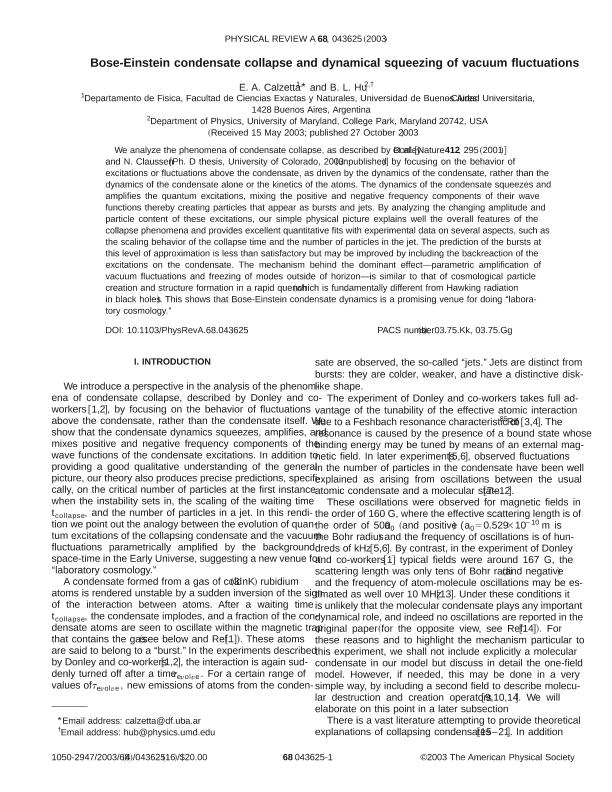Mostrar el registro sencillo del ítem
dc.contributor.author
Calzetta, Esteban Adolfo

dc.contributor.author
Hu, B.L.
dc.date.available
2019-04-26T16:51:30Z
dc.date.issued
2003-12
dc.identifier.citation
Calzetta, Esteban Adolfo; Hu, B.L.; Bose-Einstein condensate collapse and dynamical squeezing of vacuum fluctuations; American Physical Society; Physical Review A: Atomic, Molecular and Optical Physics; 68; 4; 12-2003; 1-16
dc.identifier.issn
1050-2947
dc.identifier.uri
http://hdl.handle.net/11336/75092
dc.description.abstract
We analyze the phenomena of condensate collapse, as described by Donley et al. [Nature 412, 295 (2001)] and N. Claussen [Ph. D thesis, University of Colorado, 2003 (unpublished)] by focusing on the behavior of excitations or fluctuations above the condensate, as driven by the dynamics of the condensate, rather than the dynamics of the condensate alone or the kinetics of the atoms. The dynamics of the condensate squeezes and amplifies the quantum excitations, mixing the positive and negative frequency components of their wave functions thereby creating particles that appear as bursts and jets. By analyzing the changing amplitude and particle content of these excitations, our simple physical picture explains well the overall features of the collapse phenomena and provides excellent quantitative fits with experimental data on several aspects, such as the scaling behavior of the collapse time and the number of particles in the jet. The prediction of the bursts at this level of approximation is less than satisfactory but may be improved by including the backreaction of the excitations on the condensate. The mechanism behind the dominant effect—parametric amplification of vacuum fluctuations and freezing of modes outside of horizon—is similar to that of cosmological particle creation and structure formation in a rapid quench (which is fundamentally different from Hawking radiation in black holes). This shows that Bose-Einstein condensate dynamics is a promising venue for doing “laboratory cosmology”. © 2003 The American Physical Society.
dc.format
application/pdf
dc.language.iso
eng
dc.publisher
American Physical Society

dc.rights
info:eu-repo/semantics/openAccess
dc.rights.uri
https://creativecommons.org/licenses/by-nc-sa/2.5/ar/
dc.subject.classification
Astronomía

dc.subject.classification
Ciencias Físicas

dc.subject.classification
CIENCIAS NATURALES Y EXACTAS

dc.title
Bose-Einstein condensate collapse and dynamical squeezing of vacuum fluctuations
dc.type
info:eu-repo/semantics/article
dc.type
info:ar-repo/semantics/artículo
dc.type
info:eu-repo/semantics/publishedVersion
dc.date.updated
2019-04-23T15:07:57Z
dc.journal.volume
68
dc.journal.number
4
dc.journal.pagination
1-16
dc.journal.pais
Estados Unidos

dc.journal.ciudad
Ridge
dc.description.fil
Fil: Calzetta, Esteban Adolfo. Consejo Nacional de Investigaciones Científicas y Técnicas. Oficina de Coordinación Administrativa Ciudad Universitaria. Instituto de Física de Buenos Aires. Universidad de Buenos Aires. Facultad de Ciencias Exactas y Naturales. Instituto de Física de Buenos Aires; Argentina
dc.description.fil
Fil: Hu, B.L.. University of Maryland; Estados Unidos
dc.journal.title
Physical Review A: Atomic, Molecular and Optical Physics

dc.relation.alternativeid
info:eu-repo/semantics/altIdentifier/doi/http://dx.doi.org/10.1103/PhysRevA.68.043625
Archivos asociados
